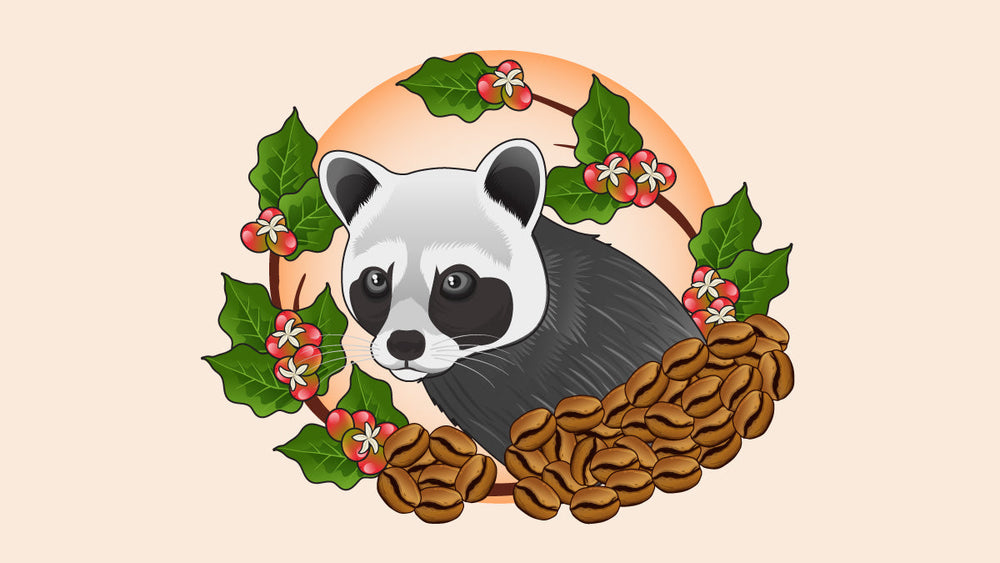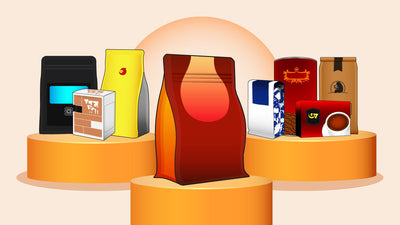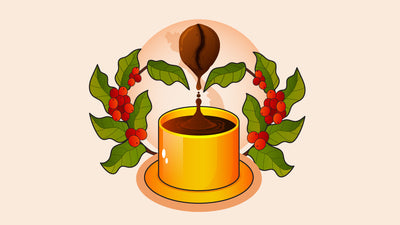Weasel coffee might sound like the name of a funky new coffee roastery, but it’s actually something of a strange delicacy in the coffee world. The beans are processed in probably the most unique way possible, and it puts some people off entirely.
We’ll take you through the ins and outs — quite literally — of weasel coffee and why it is so special for those brave enough to try it.
How is Weasel Coffee Made?

Weasel coffee starts with the Asian palm civet, an animal native to Southeast Asia. This cute creature looks a little bit like a cross between a cat and a weasel. It’s known as the latter in certain countries, including Vietnam, which is where this coffee gets its moniker.
Civets love coffee cherries, the fruit of the coffee plant that holds the coffee beans in the middle. The coffee cherries make their way through the animal’s digestive tract until they eventually make it out to the other end. The coffee beans are then extracted from the weasel’s poop and, you guessed it, used to make this popular drink.
If this has made you feel a bit queasy, it’s not as scary as it sounds. The beans are not immediately brewed and roasted as soon as they exit the weasel but instead are thoroughly washed and go through a range of processes that ensure they are safe to use.
The History of Weasel Coffee

Weasel coffee has its origins in Vietnam. While the country was occupied and colonized in the 19th and early 20th centuries, the Vietnamese people, including the coffee farmers, were prohibited from drinking coffee, as it was reserved to be profited upon by the already rich and wealthy.
The story goes that coffee farmers found coffee beans in the dung of the Asian Palm Civet, and, after washing them and trying them, they found that they were better than if they had been taken straight off of the plant.
Farmers began collecting, washing, and roasting the beans as a delicacy — now known around the world under names like Cà Phê Chồn, Kopi Luwak Coffee, Civet Coffee, Weasel Coffee, Cat Poop Coffee, and more.
Related: How To Say Coffee in Vietnamese
Why Would Someone Want to Drink Weasel Coffee?
Once you get past the details of this coffee's production, there are many who regard weasel coffee as a true delicacy. That's because the civets themselves are experts at picking out the best coffee cherries, and they won't even touch those that are unripe or where the coffee tree shows signs of sickness.
Not only do the weasels carefully curate the coffee bean quality, but something interesting happens in their guts, too. The digestive tract partially ferments the beans, altering their taste to create a coffee experience like no other.
What Does Weasel Coffee Taste Like?
Those who have had weasel coffee describe it as being rich and smooth, almost creamy, with chocolate and salted caramel notes. However, others have found there to be almost no difference between it and regular coffee, just perhaps a slightly better quality. Taste is subjective, though, so the only way you'll know if you like it is to try it yourself!
If the thought of weasel coffee doesn’t excite you, try the rich and velvety flavors of our SaiGon OG blend — grown in the lush central highlands of Vietnam and roasted using a traditional butter-roasting process to maximize flavor.

Why is Weasel Coffee So Expensive?
The other thing that can put people off of weasel coffee is its price tag. Even in places in the world where this coffee is more prevalent, you can easily be paying upwards of $10-15 for a cup.
This is because harvesting coffee beans from civet poop can be a tricky and time-consuming experience. Ethical weasel coffee farmers with free-range animals on their farms have to constantly look out for the droppings across large swatches of land, sometimes only to find two or three beans. Coffee produced from these farms can easily reach around $3,500 a kilo.
On the other end of the scale, you might be able to find really cheap weasel coffee, but the chances that it has been anywhere near a weasel are slim. Some companies create an artificial fermentation process designed to mimic what happens in the animal’s gut, allowing them to flood the market at a more affordable price.
What’s The Best Way to Make Weasel Coffee?

Weasel coffee can be prepared with just about any coffee brewing system — but if you truly want to optimize the taste of this expensive coffee, it’s important to check what species of coffee bean is being used. Each species of coffee has different flavor profiles that will affect the final brew.
Weasel coffee can be made from both Coffea robusta and Coffea arabica beans.
Vietnamese civet coffee (Cà Phê Chồn) is typically made with robusta beans. Some Indonesian Kopi Luak coffee uses this species, too (but not all of them, so check the package to be sure).
For robusta weasel coffee, we recommend using a traditional phin filter to capture the full depth this coffee has to offer. Other immersion brewing devices like the AeroPress brewer or French press work great for these beans as well.
For arabica weasel coffee, we recommend using a pour-over device like the Hario V60 or Chemex brew systems. The AeroPress, French Press, and moka pot all work great for this coffee as well.
Where Can I Try Weasel Coffee?
One of the best places to try weasel coffee is in its native countries, like Indonesia (where it is called kopi luwak) and Vietnam. You will likely find it at more boutiques, upmarket hotels, and coffee houses, although some coffee farmers provide the opportunity to see the animals up close at work before sampling the fruits of their labors.
However, depending on where you look, you should be able to find a pricy cup in major cities around the world.
FAQs: Weasel Coffee

Still curious about civet coffee? Here are some other questions that you may want answered.
1. What’s the difference between kopi luwak and weasel coffee?
There is no difference between kopi luwak and weasel coffee, as they are just different names for the same drink in different countries, Indonesia and Vietnam respectively. You may also see it being referred to as civet coffee.
2. Is weasel coffee ethical?
Most reputable farmers create weasel coffee ethically, with free-range civets that roam around the jungle and the coffee farm. But, there are some less scrupulous producers out there who keep and force-feed the civets in cages and in poor conditions. If you have doubts, any reputable coffee house selling weasel coffee should be able to give you the exact origins of their beans to help put your mind at ease.
3. Is weasel coffee healthy?
Weasel coffee is no different health-wise from any other type of coffee and shares the same benefits and risks as your regular cup.
4. Is it safe to drink weasel coffee?
Despite where it comes from, yes, weasel coffee is perfectly safe to drink! The beans are thoroughly washed and cleaned before the roasting process even begins, and any impurities are checked for.
5. What is the most expensive coffee in the world?
While pricy, weasel coffee is only the second-most expensive coffee in the world, with a price of around $1,300 per kilo on average. The most expensive coffee in the world is “processed” by a different animal entirely - the Indian elephant. Known as Black Ivory, a kilo of this stuff will set you back a whopping $2,500.
















